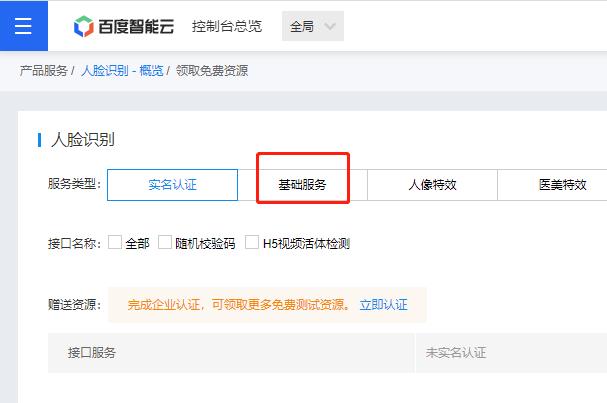最简单的人脸检测(免费调用百度AI开放平台接口)
Posted 程序员欣宸
tags:
篇首语:本文由小常识网(cha138.com)小编为大家整理,主要介绍了最简单的人脸检测(免费调用百度AI开放平台接口)相关的知识,希望对你有一定的参考价值。
欢迎访问我的GitHub
这里分类和汇总了欣宸的全部原创(含配套源码):https://github.com/zq2599/blog_demos
本篇概览
- 在检测人脸数量、位置、性别、口罩等场景时,可以考虑使用百度开放平台提供的web接口,一个web请求就能完成检测得到结果,本篇记录了从申请到真实调用的完整过程,由以下步骤组成:

注册百度账号
- 按照您的实际情况,注册个人或者企业账号,这个不多说了
登录百度智能云
- 使用刚才注册号的账号登录,地址是:https://login.bce.baidu.com/
实名认证
- 打开百度智能云的控制台:https://console.bce.baidu.com/
- 如下图,点击下图红框中的两个按钮,完成激活和实名认证:

创建应用
- 为了能够使用百度服务,需要创建一个应用
- 先选择类别,在控制台页面,操作如下图,点击红框四:

- 此刻已跳转到管理引用的页面,点击下图红框中的创建应用

- 为了免费使用百度的服务,先点击下图红框中的去领取:

- 在领取页面勾选人脸检测:

- 领取完成后,回到创建应用的页面,发现这些服务已经被勾选,如下图:

- 应用相关的信息填写完成后,提交表单即可完成创建应用
拿到API Key和Secret Key
- 在应用列表页面拿到API Key和Secret Key,这些都是调用百度服务的关键授权信息,如下图红框所示:

得到access_token
- 在使用百度提供的各种服务(如人脸检测)的时候,需要带上授权信息证明你有使用该服务的权限,这个授权信息就是access_token
- 最简单的方式就是curl命令获取
curl -i -k 'https://aip.baidubce.com/oauth/2.0/token?grant_type=client_credentials&client_id=【百度云应用的API Key】&client_secret=【百度云应用的Secret Key】'
- 这里用postman尝试上述请求,如下图,红框中就是这次请求咱们要得到的access_token信息:

- 拿到access_token,就可以开始的调用百度的服务了,如下图,官方文档说了这个access_token的有效期是30天:

- 关于百度云授权信息的更多信息请在此查看:https://cloud.baidu.com/doc/FACE/s/Tkqahnjtk
编码
- 百度关于人脸检测的文档:https://ai.baidu.com/ai-doc/FACE/yk37c1u4t
- 人脸检测服务是个web接口,也能通过操作curl或者postman来完成,但是为了在代码中使用百度的服务,这里写一段代码来完成人脸检测
- 今天的项目是个普通的maven工程,没有使用spring或者spingboot框架,只有一些简单的java类和main方法
- 首先要在项目中引入下面三个库:
<!-- 快捷代码辅助库 -->
<dependency>
<groupId>org.projectlombok</groupId>
<artifactId>lombok</artifactId>
<version>1.18.18</version>
</dependency>
<!-- 网络请求库 -->
<dependency>
<groupId>com.squareup.okhttp3</groupId>
<artifactId>okhttp</artifactId>
<version>3.10.0</version>
</dependency>
<!-- JSON处理 -->
<dependency>
<groupId>com.fasterxml.jackson.core</groupId>
<artifactId>jackson-databind</artifactId>
<version>2.11.0</version>
</dependency>
- 先新建一个对象FaceDetectRequest.java,用于保存请求参数:
package com.bolingcavalry.grabpush.bean.request;
import com.fasterxml.jackson.annotation.JsonProperty;
import lombok.Data;
/**
* @author willzhao
* @version 1.0
* @description 请求对象
* @date 2022/1/1 16:21
*/
@Data
public class FaceDetectRequest
// 图片信息(总数据大小应小于10M),图片上传方式根据image_type来判断
String image;
// 图片类型
// BASE64:图片的base64值,base64编码后的图片数据,编码后的图片大小不超过2M;
// URL:图片的 URL地址( 可能由于网络等原因导致下载图片时间过长);
// FACE_TOKEN: 人脸图片的唯一标识,调用人脸检测接口时,会为每个人脸图片赋予一个唯一的FACE_TOKEN,同一张图片多次检测得到的FACE_TOKEN是同一个。
@JsonProperty("image_type")
String imageType;
// 包括age,expression,face_shape,gender,glasses,landmark,landmark150,quality,eye_status,emotion,face_type,mask,spoofing信息
//逗号分隔. 默认只返回face_token、人脸框、概率和旋转角度
@JsonProperty("face_field")
String faceField;
// 最多处理人脸的数目,默认值为1,根据人脸检测排序类型检测图片中排序第一的人脸(默认为人脸面积最大的人脸),最大值120
@JsonProperty("max_face_num")
int maxFaceNum;
// 人脸的类型
// LIVE表示生活照:通常为手机、相机拍摄的人像图片、或从网络获取的人像图片等
// IDCARD表示身份证芯片照:二代身份证内置芯片中的人像照片
// WATERMARK表示带水印证件照:一般为带水印的小图,如公安网小图
// CERT表示证件照片:如拍摄的身份证、工卡、护照、学生证等证件图片
// 默认LIVE
@JsonProperty("face_type")
String faceType;
// 活体控制 检测结果中不符合要求的人脸会被过滤
// NONE: 不进行控制
// LOW:较低的活体要求(高通过率 低攻击拒绝率)
// NORMAL: 一般的活体要求(平衡的攻击拒绝率, 通过率)
// HIGH: 较高的活体要求(高攻击拒绝率 低通过率)
// 默认NONE
@JsonProperty("liveness_control")
String livenessControl;
// 人脸检测排序类型
// 0:代表检测出的人脸按照人脸面积从大到小排列
// 1:代表检测出的人脸按照距离图片中心从近到远排列
// 默认为0
@JsonProperty("face_sort_type")
int faceSortType;
- 其次是响应对象FaceDetectResponse.java:
package com.bolingcavalry.grabpush.bean.response;
import com.fasterxml.jackson.annotation.JsonProperty;
import lombok.Data;
import lombok.ToString;
import java.io.Serializable;
import java.util.List;
/**
* @author willzhao
* @version 1.0
* @description TODO
* @date 2022/1/1 13:30
*/
@Data
@ToString
public class FaceDetectResponse implements Serializable
// 返回码
@JsonProperty("error_code")
String errorCode;
// 描述信息
@JsonProperty("error_msg")
String errorMsg;
// 返回的具体内容
Result result;
/**
* @author willzhao
* @version 1.0
* @description 返回的具体内容
* @date 2022/1/1 16:01
*/
@Data
public static class Result
// 人脸数量
@JsonProperty("face_num")
private int faceNum;
// 每个人脸的信息
@JsonProperty("face_list")
List<Face> faceList;
/**
* @author willzhao
* @version 1.0
* @description 检测出来的人脸对象
* @date 2022/1/1 16:03
*/
@Data
public static class Face
// 位置
Location location;
// 是人脸的置信度
@JsonProperty("face_probability")
double face_probability;
// 口罩
Mask mask;
/**
* @author willzhao
* @version 1.0
* @description 人脸在图片中的位置
* @date 2022/1/1 16:04
*/
@Data
public static class Location
double left;
double top;
double width;
double height;
double rotation;
/**
* @author willzhao
* @version 1.0
* @description 口罩对象
* @date 2022/1/1 16:11
*/
@Data
public static class Mask
int type;
double probability;
- 这里有一处要注意:FaceDetectResponse对象中的字段是少于真实响应返回的字段的,这是因为这个demo不需要完整的返回内容,因此只要选择应用需要的字段定义在FaceDetectResponse.java中即可
- 最后是完整的服务类BaiduCloudService.java,如下所示,即读取图片 -> 转base64 -> 构造请求对象 -> 提交请求 -> 收到响应 -> 解析响应:
package com.bolingcavalry.grabpush.extend;
import com.bolingcavalry.grabpush.bean.request.FaceDetectRequest;
import com.bolingcavalry.grabpush.bean.response.FaceDetectResponse;
import com.fasterxml.jackson.databind.DeserializationFeature;
import com.fasterxml.jackson.databind.ObjectMapper;
import okhttp3.*;
import sun.misc.BASE64Encoder;
import java.io.FileInputStream;
import java.io.IOException;
import java.io.InputStream;
/**
* @author willzhao
* @version 1.0
* @description 百度云服务的调用
* @date 2022/1/1 11:06
*/
public class BaiduCloudService
// 转换
BASE64Encoder encoder = new BASE64Encoder();
OkHttpClient client = new OkHttpClient();
static final MediaType JSON = MediaType.parse("application/json; charset=utf-8");
static final String URL_TEMPLATE = "https://aip.baidubce.com/rest/2.0/face/v3/detect?access_token=%s";
String token;
ObjectMapper mapper = new ObjectMapper();
public BaiduCloudService(String token)
this.token = token;
// 重要:反序列化的时候,字符的字段如果比类的字段多,下面这个设置可以确保反序列化成功
mapper.disable(DeserializationFeature.FAIL_ON_UNKNOWN_PROPERTIES);
/**
* 将指定位置的图片转为base64字符串
* @param imagePath
* @return
*/
private String img2Base64(String imagePath)
InputStream inputStream = null;
byte[] data = null;
try
inputStream = new FileInputStream(imagePath);
data = new byte[inputStream.available()];
inputStream.read(data);
inputStream.close();
catch (IOException ioException)
ioException.printStackTrace();
return null==data ? null :encoder.encode(data);
/**
* 检测指定的图片
* @param imageBase64
* @return
*/
public FaceDetectResponse detect(String imageBase64)
// 请求对象
FaceDetectRequest faceDetectRequest = new FaceDetectRequest();
faceDetectRequest.setImageType("BASE64");
faceDetectRequest.setFaceField("mask");
faceDetectRequest.setMaxFaceNum(6);
faceDetectRequest.setFaceType("LIVE");
faceDetectRequest.setLivenessControl("NONE");
faceDetectRequest.setFaceSortType(0);
faceDetectRequest.setImage(imageBase64);
FaceDetectResponse faceDetectResponse = null;
try
// 用Jackson将请求对象序列化成字符串
String jsonContent = mapper.writeValueAsString(faceDetectRequest);
//
RequestBody requestBody = RequestBody.create(JSON, jsonContent);
Request request = new Request
.Builder()
.url(String.format(URL_TEMPLATE, token))
.post(requestBody)
.build();
Response response = client.newCall(request).execute();
String rawRlt = response.body().string();
faceDetectResponse = mapper.readValue(rawRlt, FaceDetectResponse.class);
catch (IOException ioException)
ioException.printStackTrace();
return faceDetectResponse;
public static void main(String[] args)
// 图片在本地的位置
String imagePath = "E:\\\\temp\\\\202201\\\\01\\\\pic\\\\1.jpeg";
// 百度云的token,是通过此接口得到的:https://aip.baidubce.com/oauth/2.0/token
String token = "24.95xxxxxxxxxxxxxxxxxxxxxxxxxxxxxx.xxxxxxx.xxxxxxxxxx.xxxxxx-xxxxxxxx";
// 实例化服务对象
BaiduCloudService service = new BaiduCloudService(token);
// 将图片转为base64字符串
String imageBase64 = service.img2Base64(imagePath);
// 向百度服务发请求,检测人脸
FaceDetectResponse faceDetectResponse = service.detect(imageBase64);
// 输出检测结果
System.out.println(faceDetectResponse);
- 确保用于检测的照片与上述代码中的路径一致(E:\\temp\\202201\\01\\pic\\1.jpeg),我这里选用了一张戴口罩的单人照,如下图:

- 执行BaiduCloudService的main方法,控制台将百度返回的检测结果打印出来,注意下面的内容并非JSON,而是lombok的@ToString注解拼接出的效果:

- 至此,通过百度的web接口调用人脸检测的实战已完成,可见有了云平台的支持,对于使用方来说开发过程变得非常简单
使用限制
- 既然是免费的,就很难十全十美,这样的web服务存在QPS限制,如下图,一秒钟不能超过两个,如果完成了企业认证,可以增加到十个,如果依旧不能满足需要,就只能付费了:

你不孤单,欣宸原创一路相伴
以上是关于最简单的人脸检测(免费调用百度AI开放平台接口)的主要内容,如果未能解决你的问题,请参考以下文章